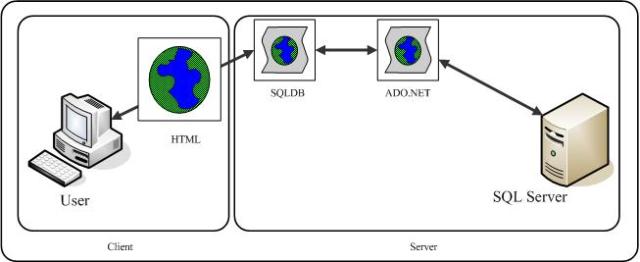Introduction
This class includes main four operators in querying database. It is simple and faster to use ADO.NET and relinquish a lot of time to design the same code. It just utilizes almost four lines of code and can run SELECT, UPDATE, INSERT, DELETE, and sorting function. But it has some limitations in development including that it suggests to get one row in return on operating SELECT because if it returns a dataset, you have to design a loop to address the dataset, it is not suitable.
Background
To use ADO.NET in operating database, however, the familiar code usually appears. I want to design a class to lower the code size.
Which Role Does the Code Play?
The code acts as a bridge to use ADO.NET to communicate with the SQL Server, and this code is suitable for Microsoft SQL Server, because it uses System.Data.SqlClient;
using System;
using System.Data;
using System.Data.SqlClient;

Simple to Operate Database for Beginner
If paradigm database is "Yourdatabase" and table is "Table1inYourDatabase".
Table1inYourDatabase:

Table1inYourDatabase's data:

We can use ADO.NET to read Table1inYourdatabase's data:
Initialize:
Set Properties.Settings.Default.YourDatabase:

using System.Data;
using SQLDBnamespace;
using System.Data.SqlClient;
static SqlConnection cn = new SqlConnection(Properties.Settings.Default.YourDatabase);
SQLDB MySQLDBTable = new SQLDB(cn);
ADO.NET:
cn.Open();
SqlCommand cm = new SqlCommand("SELECT * FROM Table1inYourDatabase WHERE uid1 = 1",cn);
SqlDataReader dr = cm.ExecuteReader();
while (dr.Read())
{
}
dr.Close();
dr.Dispose();
cm.Dispose();
cn.Close()
SQLDB:
object[] SelectInTableArray = new object[7] { 1, null, null, null, null, null, null };
object[] SelectOutTableArray = new object[7] { 0, 50, 0, 1, 0, 0, 50 };
SelectOutTableArray = MySQLDBTable.SelectTable("", 0,
SelectInTableArray, SelectOutTableArray, "Table1inYourDatabase");
The above two methods can know that ADO.NET have more repeat code to appear, and SQLDB is simpler to use. but SQLDB is suitable for a row in return.
If using parameters in ADO.NET is more complicated than SQLDB, that means more parameters and more code has to be written, but SQLDB can decrease the size.
ADO.NET:
cn.Open();
SqlCommand cm = new SqlCommand("SELECT * FROM Table1inYourDatabase _
WHERE uid1 = @uid1 and uid2=@uid2", cn);
cm.Parameters.Add(new SqlParameter("@uid1", SqlDbType.Int)).Value = 1;
cm.Parameters.Add(new SqlParameter("@uid2", SqlDbType.Int)).Value = 1;
SqlDataReader dr = cm.ExecuteReader();
while (dr.Read())
{
}
dr.Close();
dr.Dispose();
cm.Dispose();
cn.Close();
SQLDB:
SelectInTableArray = new object[7] { 1, 1, null, null, null, null, null };
SelectOutTableArray = new object[7] { 0, 50, 0, 1, 0, 0, 50 };
SelectOutTableArray = MySQLDBTable.SelectTable
("", 0, SelectInTableArray, SelectOutTableArray, "Table1inYourDatabase");
Code Conception
I do Delete table's row to interpret the conception, in ADO.NET:
cn.Open();
SqlCommand cm = new SqlCommand("DELETE Table1inYourDatabase WHERE uid1 = @uid1", cn);
cm.Parameters.Add(new SqlParameter("@uid1", SqlDbType.Int)).Value = 3;
cm.ExecuteNonQuery();
cm.Dispose();
cn.Close();
I want to use array to fit database columns and generate ADO.NET by using SQLDB class. First I use DeleteTableArray.Length to get database column length.
int TableColumnLength = DeleteTableArray.Length;
object[] temp = new object[2];
And use GetTableColumnNameAndType method to get columnname and type.
string[] TableColumnName = new string[TableColumnLength];
string[] TableColumnType = new string[TableColumnLength];
temp = GetTableColumnNameAndType(DBTableName);
TableColumnName = (string[])temp[0];
TableColumnType = (string[])temp[1];
GetTableColumnNameAndType uses sqldatareader's GetName() and GetDataTypeName() to attain value. Using loops to generate SQL query:
for (int i = 0; i < TableColumnLength; i++)
{
if (DeleteTableArray[i] != null)
{
if (FirstWhere == false)
{
cmParameterstring += " WHERE ";
FirstWhere = true;
}
cmParameter[ParameterCounter] = TableColumnName[i].ToString();
cmParameterType[ParameterCounter] = TableColumnType[i].ToString();
cmParameterstring += TableColumnName[i].ToString() +
"=@" + TableColumnName[i].ToString() + " AND ";
}
}
We get cmParameterstring, it is a SQL query and now completes the ADO.NET struct.
cmParameterstring = cmParameterstring.Remove(cmParameterstring.Length - 5, 5);
cn.Open();
SqlCommand cm = new SqlCommand("DELETE FROM " + DBTableName +
cmParameterstring + " ", cn);
for (int i = 0; i < ParameterCounter; i++)
{
cm.Parameters.Add(new SqlParameter('@' + cmParameter[i],
Convert(cmParameterType[i])));
}
for (int i = 0; i < TableColumnLength; i++)
{
if (DeleteTableArray[i] != null)
{
cm.Parameters['@' + cmParameter[ParameterCounter]].Value =
DeleteTableArray[i];
}
else if (DeleteNullFlag == 1)
{
cm.Parameters['@' + cmParameter[ParameterCounter]].Value = DBNull.Value;
}
}
cm.ExecuteNonQuery();
cm.Dispose();
cn.Close();
The above code paraphrases primate logicality and SELECT, UPDATE, INSERT functions are similar.
For a beginner user, that can be simple to operate and for a programmer, that can spare a lot of time to write similar and cumbersome code. SQLDB can't completely substitute ADO.NET, but at most part it can retrench code size.
Using the Code
protected void btnDelete_Click(object sender, EventArgs e)
{
int[] ColumnSort = new int[7] { 0, 0, 0, 0, 0, 0, 0 };
object[] DeleteTableArray = new object[7] {5, null, null, null, null, null, null };
bool DeleteFlag = MySQLDBTable.DeleteTable
("", 0, ColumnSort, DeleteTableArray, "Table1inYourDatabase");
}
protected void btnUpdate_Click (object sender, EventArgs e)
{
object[] UpdateInTableArray = new object[7] { 3, null, null, null, null, null, null };
object[] UpdateSetTableArray = new object[7]
{ null,"1234",1234, "NULL", null, null, null };
bool UpdateFlag = MySQLDBTable.UpdateTable
("", 0, UpdateInTableArray, UpdateSetTableArray, "Table1inYourDatabase");
}
protected void btnInsert_Click (object sender, EventArgs e)
{
int[] PKFlag = new int[7];
object[] InsertTableArray = new object[7] { 6, "5678", null, null, null, null, null };
bool InsertFlag = MySQLDBTable.InsertTable
("", PKFlag, InsertTableArray, "Table1inYourDatabase");
}
protected void btnSelect_Click(object sender, EventArgs e)
{
object[] SelectInTableArray = new object[7] { 1, null, null, null, null, null, null };
object[] SelectOutTableArray = new object[7] { null, null, null, null, 0, 0, 50 };
SelectOutTableArray = MySQLDBTable.SelectTable("", 0,
SelectInTableArray, SelectOutTableArray, "Table1inYourDatabase");
SelectInTableArray = new object[1];
SelectOutTableArray = new object[1];
object[,] SelectOutTableArray2 = new object[0,0];
SelectOutTableArray = MySQLDBTable.SelectTable
("SELECT DISTINCT uid, uid2, uid3 FROM Table1inYourDatabase WHERE uid>3",
0, SelectInTableArray, SelectOutTableArray, "");
SelectOutTableArray2 = (object[,])SelectOutTableArray[0];
for (int i = 0; i < SelectOutTableArray2.Length / 3; i++)
{
dropdownlist1.Items.Add(SelectOutTableArray2[i, 0].ToString() +
"\t" + SelectOutTableArray2[i, 1].ToString() + "\t" +
SelectOutTableArray2[i, 2].ToString());
}
}
Points of Interest
TO boost coding velocity.
History
- 2010.02.03 Initial version
This member has not yet provided a Biography. Assume it's interesting and varied, and probably something to do with programming.
 General
General  News
News  Suggestion
Suggestion  Question
Question  Bug
Bug  Answer
Answer  Joke
Joke  Praise
Praise  Rant
Rant  Admin
Admin 







